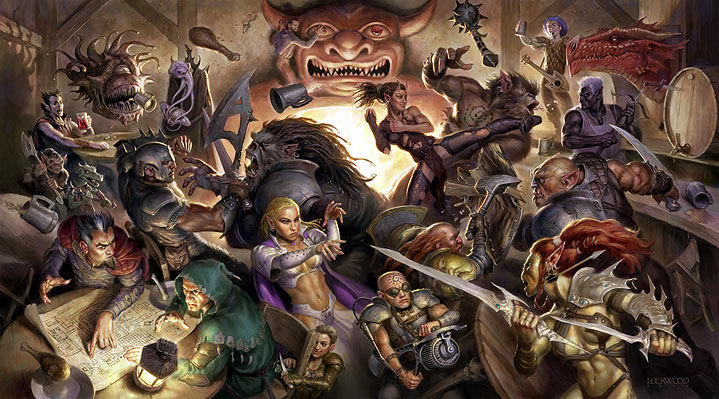I take it that isn't just a consequence of the iconic Pathfinder Paladin and the iconic 3.5e Monk being black women?
I don't know what you mean by 'consequence' here?
I take it that isn't just a consequence of the iconic Pathfinder Paladin and the iconic 3.5e Monk being black women?
Ethnicity, sexuality, male/female ratio et al are all stuff that are setting and genre specific IMCs. If the art is depicting inhabitants of a high-latitude setting like the Nentir Vale I'd expect the inhabitants to have fair skin unless there's an in-setting explanation why not. If it's a tropical latitude setting I'd expect the inhabitants to have dark skin unless there's an in-setting explanation why not - this could be magic, recent migrations, etc. Pale white humans in tropical fantasy-Africa or black halflings in fantasy-Europe both benefit from some explanation, but it only takes a moment's thought, I'm not fussy. The least likely thing and the one most in need of explanation is a wide variety of skin tones among the same 'race' (human/halfling/dwarf etc) in the same setting. This can be plausible in a multicultural port city, and a widespread empire might result in some temporary colour variety before interbreeding evens it out, but I don't like art direction that uses it as a default without need of explanation.
As far as the default 'generic' art goes, I don't have a problem with current WoTC and Paizo art except that I'd like to see the occasional not-young-and-beautiful adventurer character. Paizo have their one iconic greybeard Wizard, Ezren, but 4e D&D art was completely devoid of adventurers who didn't look like US TV actors or fashion models.

Ethnicity, sexuality, male/female ratio et al are all stuff that are setting and genre specific IMCs. If the art is depicting inhabitants of a high-latitude setting like the Nentir Vale I'd expect the inhabitants to have fair skin unless there's an in-setting explanation why not.
Both Paizo and WoTC tend to make most of their black character depictions female.
I take it that isn't just a consequence of the iconic Pathfinder Paladin and the iconic 3.5e Monk being black women?
I don't know what you mean by 'consequence' here?
But, I think this shows more people's internal biases. I mean, there's no reason that high latitude people would be fair.
Agreed. People assume that what they're familiar with is the norm, or the default, and anything different requires explicit "explanation". In our world, fair skin is an adaptation to increase vitamin D creation in higher latitudes, but it's not universal (ie Inuit), nor is the reverse universal (South American native people). The gene for adult blue eyes came from a single mutation (http://www.livescience.com/9578-common-ancestor-blue-eyes.html); that was then propagated there's no biological advantage to it.But, I think this shows more people's internal biases. I mean, there's no reason that high latitude people would be fair. That's only true in Northern Europe. North America and Asia, that certainly isn't true. In fact, that native peoples of northern latitudes tend to be pretty dark on the whole. So, why should a northern latitude setting show blond, Nordics?
Is this correct: your preference is that anything different from what you expect has an explanation?I was stating my preference, not a statement of absolute truth. I don't think there is an absolute here.
Why should vitamin D even exist in a fantasy world? Skin color could result from common genes, like hair or eyes, that express differently within members of the same family. You'd have a sibling with fair skin and dark hair, another with bronzed skin and blonde hair, a third with dark-skin and red hair, and a forth with red-toned skin and brunette hair. Hair could be kinky or curly or straight or wavy.
Evolution might not even work in a fantasy setting. Half-elves are born to people who live near elves (or elves who live near humans). Half-giants are born to people in mountainous regions. A rampaging supernatural evil leads to a rise in cockatrice, dire boars, and gorgons in later months, as the supernatural taint transforms creatures.
(I feel like this goes right along with "all ninjas are asian, all desert-societies build temples and worship the sun-god, and all northern societies are viking barbarians. Boring, and complete failure of imagination.)
Why should vitamin D even exist in a fantasy world? Skin color could result from common genes, like hair or eyes, that express differently within members of the same family. You'd have a sibling with fair skin and dark hair, another with bronzed skin and blonde hair, a third with dark-skin and red hair, and a forth with red-toned skin and brunette hair. Hair could be kinky or curly or straight or wavy.
Evolution might not even work in a fantasy setting. Half-elves are born to people who live near elves (or elves who live near humans). Half-giants are born to people in mountainous regions. A rampaging supernatural evil leads to a rise in cockatrice, dire boars, and gorgons in later months, as the supernatural taint transforms creatures.
But this is a core rulebook. Not a setting.The downside to all of this is the more you deviate from familiarity with special cases for your campaign, the more work you have to do to explain it to yourself and players so you and they don't fall back on your own experiences and assumptions. And not everyone wants to go through that much work for relatively little practical gain.
